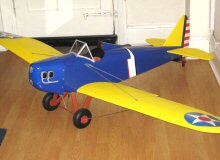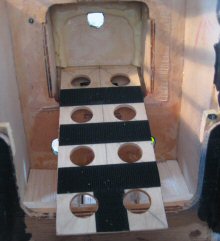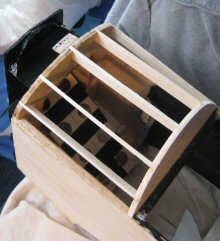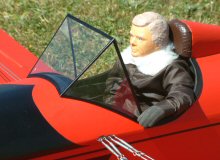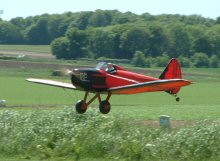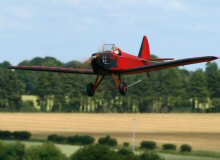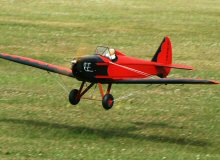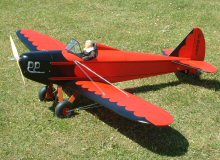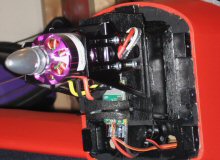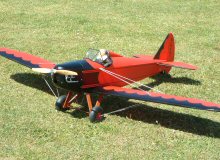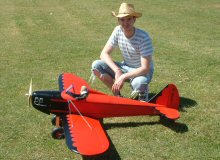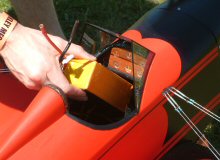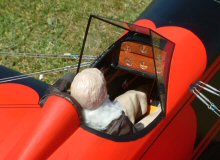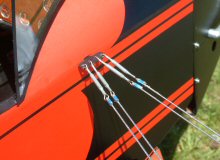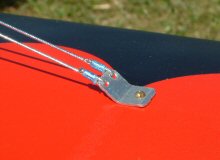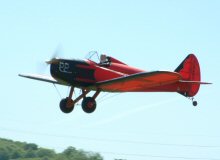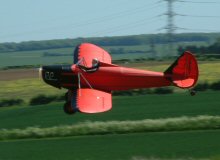|
|||
|
|
|
||
| View Shopping Cart |
| Home |
| Guides Available |
| About the Author |
| FAQs |
| Testimonials |
| Articles |
| Contact Andrew |
| Terms & Conditions |
| Mailing List |
| Links |
 |
 |
Get more high quality electric modeling information, absolutely free:
Sign up for the Gibbs Guides newsletter now!
Fly Baby - A Glow to Electric Conversion
by Stuart Warne
Article by Andrew Gibbs
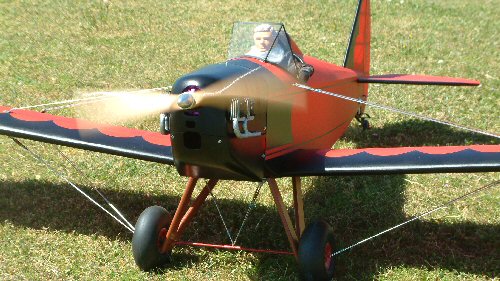
This beautiful quarter scale model of a Bowers Fly Baby comes from Stuart Warne of the UK. The model was built from a Jim Pipino plan, and spans 84 inches (2,130 mm). Stuart bought the model as he was looking for a large model, but being a busy man, he wanted to save the effort of building a complete airframe.
The model was originally flown with a 0.70 4-stroke, which was still installed at the time of purchase. Stuart removed the engine and sold it on. He then stripped the airframe of all its covering, and began converting the model to electric power. Modifications included fitting an electric motor, installing a battery tray and making provision for cooling of the power system components.
|
|
Power system
Stuart contacted 4-Max for his power system, and selected
a 380 Kv motor, 6S 5,000 mAh LiPo and a 16 x 9 propeller.
With this combination the motor draws 45 Amps, equating
to just over 1,000 Watts of power. This is roughly equivalent
in power to the previous 4-stroke (4-cycle) glow engine.
As an i.c. model it weighed 13½ lbs, but in electric
format it's lighter, tipping the scales at just 11 lbs.
Power loading
The power loading is just under 100 Watts per lb, which is a generous
figure for a scale light aircraft. The battery provides flights of around
15-20 minutes, indicating that the model spends most of its time throttled
well back - if one can use such a term for an electric motor!
|
|
|
|
Kv, propeller rpm and pitch speed
Stuart’s choice of a 380 Kv motor (i.e. a design
rpm per volt of 380) means that the on a 6S battery, which
has a nominal voltage of around 22 Volts, the no-load
rpm would be around 8,300 rpm (22 x 380 = 8,300). In practice,
with the load of a propeller, the rpm will be about 15%
less, giving an actual prop rpm around 7,100.
This means that the pitch speed of the 16 x 9 prop, which is the forward speed it would achieve if there were no airframe drag, is around 63 mph (data taken from a table in the Gibbs Guide to Power Systems). I estimate that the model probably flies around 40 - 45 mph. When choosing a power system, for best efficiency I usually suggest that the pitch speed should be somewhere in the region of about 25 % higher than the model’s maximum level flight speed. In this case then, a pitch speed of around 50 – 56 mph would be appropriate, not far off the 63 mph just mentioned. The model flies very well and has long flight times so that makes the power system a successful one!
Choosing props is never an exact science; the best we can do is make a sensible estimate of what is likely to work well, and see how the chosen prop works out, perhaps also trying out a couple of alternatives.
Click
here for more information on props and Electric Power
Systems
|
|
|
|
|
|
Flying the Fly Baby
The model has plenty of power, but Stuart told me that
he had a problem with the model’s aileron response,
saying that it would not turn easily. This made me suspect
that the problem may be adverse yaw, which occurs when
the down going aileron produces an increase in drag, such
that the model has a tendency to yaw in the opposite direction
to the intended direction of turn. An effective solution
for this is to adjust the aileron travel so that the down
going aileron has a reduced travel compared to the up
going one. This is known as differential aileron and it
works because the additional drag caused by the down going
aileron is reduced.
Adverse yaw and affects full size aircraft as well, and differential aileron is particularly useful with high aspect ratio wings, such as found on gliders and certain light aircraft (model and full size) such as Piper Cubs. Setting up ailerons in this way carries an additional bonus in that tip stalling becomes less likely on approach, making for safer flying. I almost always set my own models up with differential aileron travel.
| Fly Baby power system data 6S 5,000mAh LiPo |
|||||
| RPM (approx) | Voltage | Current (Amps) |
Power (Watts) |
Pitch speed | |
| Full throttle | 7,100 | 22.2 | 45 | 1,000 | n/a |
| Cruising flight | TBA | TBA | TBA | TBA | n/a |
Anyway, I questioned Stuart about the way the model was set up, and he told me that the ailerons had an equal throw in both directions. I suggested that he change the travel so that the down going aileron had perhaps half the travel of the up going surface. He duly made this change, and reported that it did indeed help, but that the model also required rudder input to make turns. This was no surprise to me; plenty of high aspect ratio aircraft need to be turned using a combination of rudder and aileron. Indeed, some aircraft need a lot more rudder than aileron to enter a turn, and Stuart later told me this was indeed the case with his Fly Baby. He later said “I’ve found now that if I use the rudder to enter into every turn it ‘holds’ the turn in a much more controlled fashion. In fact now I find that I turn mostly with the rudder, only using the ailerons when needed”
Thank for sharing your lovely model here, Stuart.
|
|
|
|
|
|
| Fly Baby technical data | ||
| Span | 2,160 mm | 85 inches |
| Length | 1,420 mm | 56 inches |
| Flying weight |
4,990 g | 11 lb 0 oz (176 oz) |
| Wing Area | 0.74 sq m | 1,150 sq in |
| Wing Loading | 00 g/dm | 22 oz/sq ft |
| Battery | 6S 5,000mAh LiPo | |
| Motor | PPO5065-380 7 turn | |
| Propeller | 16x9 | |
| Max Power | 1,000 W | |
| Power Loading (max power) | 59 W/kg | 130 W/lb |
| Power Loading (average power) | TBA | |
| Control functions | Ailerons, elevator, rudder & throttle. | |
Note: All the power system themes touched on here such
as power loading, pitch speed and much more are explained
clearly in the 3-part series on Electric Power Systems
